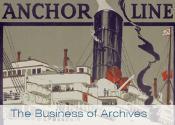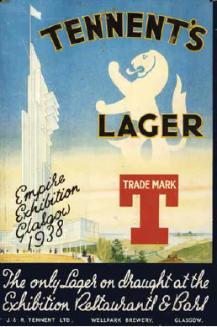Money in them thar Archives
Published: 16 December 2014
The latest Adam Smith Business School "Aspire" magazine reveals the University's role in protecting Scotland's industrial and commercial heritage.
When I look back at a career in journalism that spanned 33 years, I sometimes wonder if I performed the role of some albatross or grim harbinger of doom, writes the Communications Office's Phil Taylor in the Christmas edition of Aspire.
 It was a career first in print then in broadcasting that began on Merseyside. Here, in the early 1970s, I witnessed at first hand the death throes of Liverpool as an international sea port and city of industry. Incredibly, in those days, Liverpool was still home to a daily newspaper serving the shipping industry, the Liverpool Journal of Commerce. By the 1970s, years of decline had seen the old docks lining the River Mersey falling into disuse. The containerisation of international freight saw the development of Seaforth to the North of the old docks, but even then the new facility was being overtaken by ports like Southampton and Felixstowe. Casual dock labour, often blamed for a culture of poor time-keeping at the Merseyside car plants, was already a thing of the past. Britain was now looking east to Europe and not westwards to America.
It was a career first in print then in broadcasting that began on Merseyside. Here, in the early 1970s, I witnessed at first hand the death throes of Liverpool as an international sea port and city of industry. Incredibly, in those days, Liverpool was still home to a daily newspaper serving the shipping industry, the Liverpool Journal of Commerce. By the 1970s, years of decline had seen the old docks lining the River Mersey falling into disuse. The containerisation of international freight saw the development of Seaforth to the North of the old docks, but even then the new facility was being overtaken by ports like Southampton and Felixstowe. Casual dock labour, often blamed for a culture of poor time-keeping at the Merseyside car plants, was already a thing of the past. Britain was now looking east to Europe and not westwards to America.
In 1978 I left Liverpool to work in Glasgow, just as Merseyside's massive Tate and Lyle sugar refinery was getting ready to close. That same year, workers at the British Leyland car plant at Speke near Liverpool gave in to the inevitable closure of the factory that had produced arguably one of the worst cars ever made, the Triumph TR7…unhappily nicknamed “the Wedge” or “the flying doorstop”. As I arrived in the West of Scotland, thousands upon thousands of industrial jobs were being shed here too. It was the death of the old order of things.
 In 1972 Jimmy Reid, the Upper Clyde shipyard union convener, activist and orator, made his legendary rectorial address to students at the University of Glasgow on the subject of alienation. He was angry at the way working people were being heaped on the industrial rubbish pile. It was a speech reprinted verbatim in the New York Times.
In 1972 Jimmy Reid, the Upper Clyde shipyard union convener, activist and orator, made his legendary rectorial address to students at the University of Glasgow on the subject of alienation. He was angry at the way working people were being heaped on the industrial rubbish pile. It was a speech reprinted verbatim in the New York Times.
I spent the next fourteen years watching the same process of de-industrialisation unfold North of the Border. The list of closures is very familiar: most of the shipyards, the Linwood car plant, the Singer sewing machine factory at Clydebank (the world’s largest), Ravenscraig and a host of other steelworks.
One of my abiding memories is watching the last rolling of steel at the Gartcosh steel mill. Steel workers are not renowned for wearing their emotions on their sleeves; that day was very different, I recall.
The number of jobs that were vaporised, along with the cooling towers of North Lanarkshire, was staggering: Ravenscraig's death led to the loss of 770 livelihoods with an estimated 10,000 jobs disappearing downline. Linwood’s closure put 4,800 on the dole. Singer’s employed 15,000 people in 1960: when the plant closed in 1980, the number had fallen to about 3000. Anyone who remembers the before and after of the industrial decline must surely find it hard to believe that manufacturing now accounts for just 12 percent of the UK’s GDP.
Hopelessness
It’s hard to estimate the human cost of this industrial upheaval. Perhaps it is best left to Jimmy Reid who, in his address to students at the University of Glasgow in April 1972, gave his own definition of the alienation it was causing:
“It is the cry of men who feel themselves the victims of blind economic forces beyond their control. It’s the frustration of ordinary people excluded from the processes of decision making. The feeling of despair and hopelessness that pervades people who feel with justification that they have no real say in shaping or determining their own destinies.”
But in some senses, these industrial giants of the past have not disappeared entirely. And in one of those twists in the tail beloved of history, those stories and records of industrial might and prowess are now serving some of the new industries and services of the 21st century.
Treasure trove
 The shipyards and other industrial behemoths live on in the records of Scotland’s National Business Archive at the University of Glasgow where the stories of our nation’s great industrial and commercial ventures are collected and shared. This treasure trove of industrial and commercial history exists thanks to some very far-sighted thinking just as the industrial decline reached its peak.
The shipyards and other industrial behemoths live on in the records of Scotland’s National Business Archive at the University of Glasgow where the stories of our nation’s great industrial and commercial ventures are collected and shared. This treasure trove of industrial and commercial history exists thanks to some very far-sighted thinking just as the industrial decline reached its peak.
The University’s academics recognised early on that the records of Scottish businesses, business-related bodies and industrialists provide crucial commentary not only on Scotland’s economic, political and social development, but also on that of the UK and many countries around the world.
Product development
Records are firstly important as a business asset. They contain information vital for business continuity and are often necessary to meet both short and long-term legal obligations. They provide internal information relating to an organisation’s successes and failures which are used to inform the thinking of current business leaders. They can drive competitive advantage and support and inspire business and product development. They can also aid marketing and decision making as well as providing evidence for legal and brand protection.

The Scottish Business Archive at the University of Glasgow is one of the largest collections of business records worldwide. The archive represents the business interests of Scotland from the eighteenth century to the present. The collections reflect the contribution that Scotland’s business, industry and enterprise has made, and continues to make, to the world economy. The University still actively works with the Business Archive Council of Scotland to document the most influential aspects of Scottish business today.
This year saw the start of a project that resulted from a visit from Humza Yousef MSP, Minister for Europe and International Development, last summer. With his support, the Business Archives Council of Scotland is now surveying the records of Scottish Asian business to ensure their ground-breaking contribution to Scotland’s economy is remembered by successive generations.
Yousaf commented: “It was fascinating to see the wide variety of businesses that have started in Glasgow and across Scotland, and it shows how this city led the way in industries such as ship building and mining. It makes me very proud that so many businesses with great heritages began in Glasgow.”
The Scottish Business Archive offers a corporate archive service to the Scottish business community. It works closely with the Business Archives Council of Scotland to offer advice and support on the management of information resources. From its base on the Gilmorehill campus, the Archive provides a professional archive management service to clients such as House of Fraser and Thales (the inheritors of the prestigious Glasgow optical engineering company Barr and Stroud.
The 400 archive collections represent 1,000 companies from banking, confectioners and distillers to retailers, solicitors and undertakers. Professor Ray Stokes, Head of the University’s Centre for Business History in Scotland says: “The Scottish Business Archive is an amazingly rich and varied resource that contains vital primary research material for all sorts of historians, whether they focus on business, labour or social history on the one hand or the history of design or technology on the other. But it is more than that: the collections enable the construction of bridges between academic history writing and the general public, between Scotland and the rest of the world and between the past and the present.“
Anchor Line
How does it impact on business and commerce today? You’d be surprised at the interest the Scottish Business Archive has generated. When the well-known Glasgow-based restaurant group Di Maggio’s took over The Anchor Line building in Glasgow city centre, they turned to the University’s Archive Services to help create their Anchor Line Bar & Grill, an American-Scottish restaurant with a Prohibition-era interior theme. The head of the company, Tony Conetta, said telling the story of the important Scottish company that had previously occupied the building was an important feature of the restaurant’s design and ambience.
Yet another famous Scottish name – and brand – is Tennent’s, the iconic Scottish lager, dating back to its inception in the 19th century. Brewed at Glasgow’s historic Wellpark Brewery, Tennent’s lager has a long and proud heritage and in 2010 celebrated its 125th anniversary. For the business, the Tennent’s archive is a key asset and hosts a wealth of facts, figures and memorabilia spanning hundreds of years of the brewery’s history. The archivists at the University of Glasgow have been providing historical brand information to support marketing and advertising since the 1980s. They are seen as key partners in the important task of preserving this information for many more years to come.
Through this arrangement, the University of Glasgow ensures the preservation of the archive in its temperature and humidity controlled repository and provides enquiry services for both Tennent’s staff and external researchers. In this way Tennent’s gets maximum value from its heritage assets.
They say that journalism is the first, rough draft of history; it certainly seems that way to me. For areas like Merseyside and Clydeside, the 70s and 80s were traumatic and hard. Politicians are still dealing with the aftermath of industrial decline to this day. We should be grateful, perhaps, to the archivists who are helping us to remember our industrial past, to celebrate it, and even to use it for commercial gain. I think Jimmy Reid would have approved.
To find out more about how we work with the business community to ensure today’s great business achievements are part of tomorrow’s history, visit:
www.gla.ac.uk/services/archives/businesses/
The full version of this article will be in the Winter edition of Aspire magazine, produced by the Adam Smith Business School.
First published: 16 December 2014
<< December

